Awards Ceremony, President's Day 2016 (Wednesday 8 June)
Huw Clarke (President’s Award)
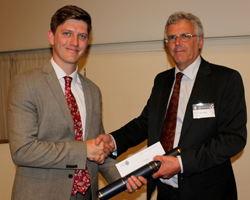 The first President’s Award today goes to Huw Clarke of Cuadrilla Resources. Huw is a graduate of the University of Bristol, where he attained his Masters degree for a project involving the use of micro-seismic datasets and anisotropic shear-wave splitting analysis to infer stress-induced crack alignment within a tight reservoir – a thesis that was published in Geophysics in 2011.
The first President’s Award today goes to Huw Clarke of Cuadrilla Resources. Huw is a graduate of the University of Bristol, where he attained his Masters degree for a project involving the use of micro-seismic datasets and anisotropic shear-wave splitting analysis to infer stress-induced crack alignment within a tight reservoir – a thesis that was published in Geophysics in 2011.
He is currently Senior Geoscientist with Cuadrilla, working as operation/well-site geologist on all company-operated wells, and is team leader for new venture opportunities, onshore Europe. He is team leader on the induced seismicity and hydrology aspects of the UK’s first environmental impact assessments for planning submissions associated with hydraulically fractured lateral wells in the Bowland Basin.
Ladies and gentlemen, Huw Clarke
Ann Victoria Rowan (President’s Award)
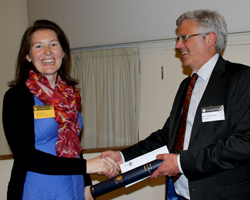
The second President’s Award goes to Ann Rowan of the Department of Geography, University of Sheffield. Ann Rowan is currently Vice-Chancellor’s Fellow at Sheffield University, a four-year fellowship that will lead to a permanent academic post is September 2019. Prior to this she was Ice and Climate Research Fellow at Sheffield and Project Leader for Quaternary Geology in the Geology and Regional Geophysics group of the British Geological Survey.
She obtained her PhD from the University of Manchester for Braided River Response to Glacial-Drainage Capture and Climate Variation through the last Glacial Maximum (2012), and followed this with a spell as C3W Research Fellow at Aberystwyth where she worked on Sensitivity of a monsoon-dominated Himalayan glacier to climate change.
In 2015 she was invited to deliver the Penck Lecture, the Outstanding Young Geoscientist keynote in geomorphology, at the EGU General Assembly in Vienna.
Ladies and gentlemen, Ann Victoria Rowan.
We now come to the Funds of the Society.
Anja Schmidt (William Smith Fund)
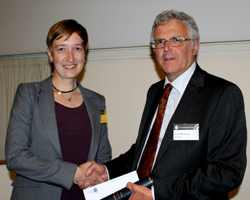
The William Smith Fund goes to Dr Anja Schmidt, of the University of Leeds. Anja has already garnered several prestigious awards, including the Springer Thesis Prize of 2012, which led to a published book in 2013, and the 2015 George Walker Award.
Anja has published a series of innovative and influential papers examining the impacts of volcanic eruptions on air quality, aircraft hazard and palaeoclimate. She has already acted as an adviser to the UK Government on the risk posed by Icelandic eruptions.
She has quantified the impacts of tropospheric volcanic aerosol on the pre-industrial atmosphere, and how this affects anthropogenic climate change. She also showed that a present-day Icelandic Laki-type eruption could cause tens of thousands of premature deaths in Europe.
Anja Schmidt, who trained initially as a geologist, is one of a very small number of scientists to have established a successful career as an applied geoscientist working at the boundaries between volcanology, atmospheric and climate science, and geohazards. Her work has contributed significantly to our understanding of climate, air quality, aircraft hazards and ancient climate as well as the effects of large eruptions upon the Earth’s biota.
Craig Magee (Murchison Fund)
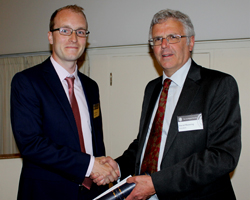
The Murchison Fund of the Society is awarded to Craig Magee of Imperial College London.
Craig Magee’s research focuses on determining how sub-volcanic igneous intrusions are emplaced, and so work out how they affect basin evolution and the building of volcanic edifices.
Already a Society laureate, he co-authored the paper awarded the ‘Young Author of the Year’ prize in 2013, won the Mike Coward Award and Shell Prize for best postgraduate presentation at the Tectonic Studies Group Conference in 2010, and was highly commended for the Ramsay Medal by the Tectonic Studies Group in 2013.
Since completing his PhD in 2011, Craig has established an impressive research portfolio spanning traditional field analysis of the complex igneous geology of the Scottish Highlands, to cutting-edge seismic reflection image-analysis of rifted margins around the world. He also employs structural field techniques, quantitative petrology and rock magnetic analysis in order to identify magma flow patterns in variable igneous sheet-intrusions.
Now a Junior Research Fellow at Imperial College, he is turning his attention to the Danakil Depression, Ethiopia; a unique region of transition from continental rifting to incipient ocean spreading.
Tracy Aze (Lyell Fund)
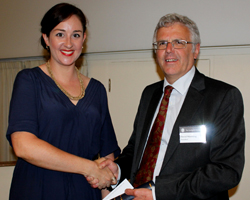
The Lyell Fund of the Society is awarded this year to Dr Tracy Aze of the University of Leeds.
Tracy is an outstanding early career scientist whose research spans the palaeobiology of foraminifera, evolutionary science, climate change and ocean acidification, with a publication record of the very highest quality.
After completing her PhD in Cardiff in 2011 she stayed on to complete two years of postdoctoral work before moving to Oxford to take up an independent research fellowship at the University Museum of Natural History. In 2014 she took up a permanent lectureship in Marine Micropalaeontology at the University of Leeds.
Her research has appeared in high-profile, high-impact journals, including papers in Geology, Biological Reviews, Science and Proceedings of the Royal Society. These papers are beginning to attract significant citations.
Tracy’s research spans a number of the ‘big questions’ in Earth science, and she combines this impressive record with teaching of the highest calibre, and outreach activities - communicating science to the public as a gifted and lively presenter.
Mitchall D'Arcy (Wollaston Fund)
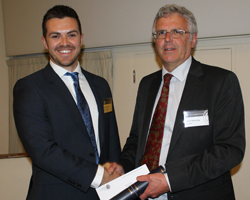
The Wollaston Fund of the Society is awarded this year to Dr Mitch D’Arcy of Imperial College London.
Mitch D’Arcy, who obtained his PhD from Imperial College last year, researches the sensitivity of sediment routing systems to climate change, using field and modelling techniques. His work, partly financed by a Society fieldwork grant, described in Geoscientist in October 2014, focuses on assessing the reliability of geomorphic and sedimentary archives as records of climate change, developing new tools for ageing alluvial fan surfaces, and constraining the ways in which sediment grain size distributions propagate through routing systems.
Mitch has been able to show that catchments in the SW United States respond most dramatically to increased storminess and extreme weather rather than climate averages, and has tied his results to records of sea-surface temperatures and atmospheric water content. This helps scientists re-evaluate which climate data (averages, or ranges) are most useful in understanding the messages of stratigraphy.
Paul Denton (R H Worth Prize)
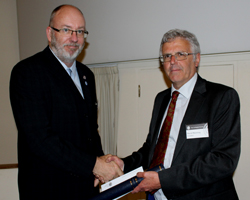
The R H Worth Prize celebrates the practice and encouragement of geological science by and among ‘amateurs’, a term we interpret broadly. This year we are pleased to award it to Mr Paul Denton of the British Geological Survey.
Paul Denton initiated, and has for more than 10 years been the driving force behind, the highly successful ‘School Seismology’ Programme. This exciting project has helped to create a whole new generation of youngsters who, through this programme, have gained unforgettable experience of conducting original science, communicating their findings with other ‘researcher-pupils’ across the world, and come thereby to understand the intimate links between science and society – through the sheer impact of earthquakes, and by means of communicating seismological information to the public in a useful way.
The destructive power of seismic forces is inherently fascinating to everyone, and especially children. This project enables pupils to use quite simple equipment to make real scientific measurements for themselves, capitalises brilliantly on the appeal and utility of such measurement to convey a wide range of scientific concepts in an exciting and participative way - promoting physics, geography and geology, as well as societal issues like hazard management, risk reduction and communication.
The project provides a wide range of support materials for teachers and pupils, including training videos, workshops and links, software support and even funding opportunities through the BGS website and in collaboration with Integrated Research Institutions for Seismology (IRIS) in the USA.
Paul Denton, for these outstanding efforts, and their tireless promotion through the Earth Science Teachers Association and their magazine Teaching Earth Sciences, please accept, with our deepest admiration and respect, the R H Worth Prize of The Geological Society of London.
Paul Denton replied:
Mr President, Fellows, Ladies and Gentlemen, I am proud and honoured to receive the 2016 R H Worth prize. My work involves trying to enthuse and inspire school children (and their teachers) in their studies of Geoscience. This work is a reflection of the support and encouragement that I have enjoyed working in this field.
In 2005 I came across some inspirational work by a secondary school science teacher, Stewart Bullen, who had used his own homemade seismometer system to record signals from the devastating Boxing Day Sumatra and was using this data to make science lessons relevant and exciting for students.
This work seemed not only important and useful but also something that my career in observational seismology had enabled me to turn into a national program. So with the support of my Leicester colleagues I embarked on a journey of creating a school seismology network in the UK. This has involved working closely with university academics and school teachers across the UK, in Europe, the USA and across the world.
The work was helped at various times with financial support from the National Lottery, the Royal Society, the Royal Astronomical Society and British Geophysical Association, the Petroleum exploration society of Great Britain, The Scottish Oil Club, the European Union and my present employer the British Geological Survey.
I spent the first half of my career enjoying the delights and challenges of geophysics fieldwork at Leicester University under the mentorship of two inspirational academics Professor Peter Maguire and Professor Aftab Khan, and I would especially like to thank these two for sharing the enjoyment and fun of geoscience with me and inspiring me to pass on this enthusiasm to future generations. Thank you all.
We come now to the Society’s Distinguished Service Award.
Catherine Mével (Distinguished Service Award)
The first of these goes to Catherine Mével of the Institut de Physique du Globe, Paris (who unfortunately cannot be with us today).
Catherine Mével is now an emeritus CNRS scientist at IPG Paris, since her retirement in 2012. Previously, she worked as CNRS Researcher at the Université Pierre et Marie Curie before joinging IPGP in 2000. She was an adviser for Marine Geosciences at CNRS, and Director of the ECORD Management Agency.
She has made many exceptional contributions to marine geoscience as a researcher, specialising in ocean lithosphere. But, in the context of this award, we choose instead to celebrate her role as the principal driving force behind the European component of the first decade of the Integrated Ocean Drilling Programme. We also recognise by this award her distinguished leadership of the European Consortium for Ocean Research Drilling (ECORD), which pooled the entire European effort in IODP. Without her efforts, Europe would not occupy the strong position it now holds as it moves into IODP’s next decade as an independent platform provider for the International Ocean Discovery Programme.
Crucial to this achievement has been the central role of ECORD, the body that combines the funding contributions of 16 European nations and Canada. As its Director, Catherine was called upon to perform the by no means straightforward role of representing Europe in negotiations with the lead agencies of IODP (USA and Japan) to join the programme. She also acted as the contact between Europe and IODP and represented Europe in all key IODP panels, often brokering the sometimes difficult relationships between the various funding agencies involved.
Catherine Mével, in recognition of your unconquerable enthusiasm and dedication in a role that could alas be described, all too accurately, as ‘thankless’, we are delighted to mark our appreciation by awarding you the Distinguished Service Award of The Geological Society of London.
Catherine Mével replied:
President: I am very honoured to receive this Award from the Geological Society. Never before in my career had I considered moving to administration, but when I was offered to manage ECORD, I seized the opportunity. I knew what my debt was to the ocean drilling programme as a scientist and I thought that it was my turn to help.
The challenge was exciting: set up a new structure to allow Europe to play a major role in scientific ocean drilling and operate “mission-specific platforms” to open new areas for drilling. For me, this involved working with the funding agencies at the European and international level, but also with the British Geological Survey that provided its drilling expertise, and with Bremen University that had a long experience in core curation. I soon discovered that we could have divergent views that had to be reconciled and that we had to deal with painful administrative regulations. But we all united our efforts towards the same goal.
Although it moved me away from doing my own science, I really enjoyed the job. I interacted with an incredible number of people around the world, both at the scientist and the funding agency levels. I learned that to make an international program work, it is necessary not only to promote the best science, but also to understand that we all come from different cultures.
This was particularly crucial when dealing with my American and Japanese colleagues. Helping to make things happen for the science community is immensely rewarding. I cannot describe my excitement when the first ECORD MSP expedition drilled the Arctic seafloor. And I am really pleased that young European scientists continue being involved in drilling within IODP. I want to pass the message that serving the community also brings you a lot of satisfactions. And I thank all my colleagues and friends who have helped me in my managing activities.
Edmund Nickless (Distinguished Service Award)
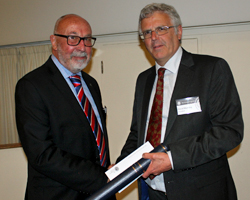 The second Distinguished Service Award goes to someone well known in this great building, over which no one person since 1874 can be said to have exerted greater influence: I speak, of course, of former Executive Secretary, Mr Edmund Nickless.
The second Distinguished Service Award goes to someone well known in this great building, over which no one person since 1874 can be said to have exerted greater influence: I speak, of course, of former Executive Secretary, Mr Edmund Nickless.
After a distinguished 15-year career in the British Geological Survey, Edmund transferred to NERC headquarters in 1983, acting as secretary to the Earth Sciences Committee. He was responsible for the Deep Geology and Ocean Drilling programmes (among others) as well as research grants and awards. He also stimulated and won support for many multidisciplinary, multi-institution collaborations, like the British Mid Ocean Ridge initiative.
From 1989 to 91 he was seconded to the Science and Technology secretariat of the Cabinet Office, gaining first-hand experience of giving scientific advice at the very highest level of Government. Returning then to BGS, in 1997 he was appointed Executive Secretary of the Society, bringing all his experience in the research community, scientific administration and Government, to the service of the science he loves.
To this new task he brought energy, vision and political nous, working with staff colleagues, successive Presidents, Council members and Officers, to guide the Society through 18 years of change - including its triumphant Bicentenary in 2007. He helped transform the Society, into a vibrant and forward-looking learned and professional institution meeting the needs of its members and recognised worldwide not only as the oldest, but also as the most innovative, respected and trusted body of its kind.
Edmund Nickless, it is impossible to do real justice to the nature and extent of your contributions. You have devoted your working life to strengthening both science and profession, demonstrating qualities of leadership that have made yours an unforgettable presence, nationally and internationally. Your work is your passion, and your commitment to nurturing future generations of geoscientists, unrivalled.
Please accept, with our undying thanks, the Distinguished Service Award of the Geological Society of London.
Edmund Nickless replied:
Thank you, President for your fulsome words: I hardly recognised the person described.
On graduating from Queen Mary College I had two choices – to do research or to join the Institute of Geological Science then expanding very rapidly under the visionary directorship of Sir Kingsley Dunham. The practical application of geoscientific knowledge for the public good attracted me and I sensed that “the Survey” would provide me with a wider range of challenges than academic research. So it turned out to be, and with successive early promotions by the age of 29 I was in my career grade, Principal Scientific Officer, now less glamorously called ‘Grade 7’.
Firstly in London and then in Edinburgh where I volunteered to go to avoid Keyworth where the Survey was being relocated (the Pole of Inaccessibility as a colleague called it), I worked on a range of projects providing geological information in formats accessible to non-technical audiences. So the moves to NERC and then the Cabinet Office were logical and required me to act as an intermediary while not misrepresenting the science.
In all the jobs I have done it has been my privilege to work with many able people who have inspired me, but my greatest satisfaction has come through many of the Society’s activities as its Executive Secretary : one was the opportunity to encourage younger people in developing their careers in geoscience and working with Geology for Global Development and the Young Earth Scientist network. Another was to bridge to other geoscience communities at home and overseas.
I am indebted to the Society for recognising me with the Distinguished Service Award. None of this would have been possible without the support of the Society’s greatest asset, its staff. It was a privilege and honour to serve the Society. In mitigation all I can say is “I was only doing my job”
Richard Howarth (Sue Tyler Friedman Medal)
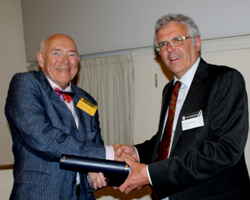
The Sue Tyler Friedman Medal, awarded for excellence in research into the history of geology, goes this year to Dr Richard Howarth of University College London.
Richard Howarth’s career as a mathematical geologist was largely built on finding and using statistical techniques useful in the interpretation and analysis of geological data. He therefore first became interested in the history of mathematics and statistics, and in particular the development of graphical methods of data display.
This led to an interest in how graphical methods were gradually taken up by the geological community in the 19th Century (for example, the use of stereographic projection in structural geology and the ternary diagram in sedimentary and igneous petrology).
By the early 1990s, Richard had also become interested in the people who used such early tools, and wrote to the editors of the Dictionary of National Biography to suggest the names of some geological 'missing persons' who might usefully be included in a future edition. After writing a number of these himself he was led more deeply into biographical studies, notably in a memoir about Frank Coles Phillips, who had taught him as an undergraduate at Bristol, which he co-authored with Phillips’s staff colleague, Bernard Leake. Richard is currently completing for publication a Dictionary of Mathematical Geosciences - with historical notes, which combines both fields of interests.
Richard Howarth has now published over 80 papers and books dealing with history of geology, and is a recognised world authority on the history and development of geophysical and mathematical methods in geology. He has also served both the Geological Society and Geologists’ Association in a bewildering variety of significant roles, from Trustee, to journal and book editor, to working group member.
Richard Howarth replied:
Mr President, Council Members, ladies and gentlemen; Not considering myself a professional historian of geology, I was astonished to learn that I was to receive the Sue Tyler Friedman Medal, and I heartily thank the Society for their generosity.
It was established in 1988 by the chemist, sedimentologist, petroleum-geologist, educator, and historian of geology, Gerald Friedman, who died in 2011 (aged 90), in honour of his wife. Both were pre-War émigrés from Germany to the United States, arriving in 1938 and 1945 respectively, Gerald having gained a BSc in chemistry with geology at the University of London en route.
After their marriage in 1948, Sue, by training a nurse, became (in her own words) “a geologist by osmosis”, acting at various times as Gerald’s geological assistant and business manager. Sharing an interest in the history of geology, they gradually amassed a collection of some 800 rare books and manuscripts, now held at the Rensselaer Polytechnic Institute, Troy, New York State, where Gerry taught for 20 years and where they established the Centre for Applied Geology in 1983.
In the 1960s, inspired by Gerry’s and William Krumbein’s early work, I thought I might become a sedimentologist but, with the rise of computers, I became a mathematical geologist instead. Latterly, my interest in past geological and geophysical techniques and the people who used them has grown.
In my case, the osmosis has benefitted from encouragement from many previous awardees: Martin Rudwick, William Sarjeant, Hugh Torrens, David Oldroyd, Gordon Davies, Jim Secord, Ted Rose and David Branagan; not to forget my old PhD supervisor, Bernard Leake, who has taken a keen interest in my career over the years. To all these persons (some of whom, sadly, are no longer with us), and to the Geological Society, I am extremely grateful. Thank you all.
Henry Emeleus (Prestwich Medal)
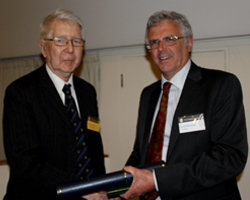
The Society’s Prestwich Medal goes this year to a geologist who has devoted 60 years in the service of the geological community, teaching generations of undergraduate students, undertaking pioneering fieldwork and research and producing many maps and memoirs of Scottish and Greenland geology - Dr Henry Emeleus of Durham University.
Henry Emeleus is without doubt a leading expert on the formation of igneous rocks in North West Britain and Greenland. His outstanding talent and energy as a field geologist, and intuitive ability to discern relationships between and within rocks, have resulted in the production of numerous geological maps for major international organisations – including over 100 published papers, three BGS maps of NW Scotland, and a further 7 published map sheets for the Geological Survey of Greenland, and later of Denmark .
His early research centred on the Western Mournes and Slieve Gullion. Later, for the Geological Survey of Greenland, he worked on Precambrian intrusions of southern Greenland and the Paleocene lavas of East Greenland. His more recent research has concentrated on the Tertiary geology of Britain’s north and west.
In addition to his extensive research and mapping work, Henry has served as Sub-Dean for Durham’s Faculty of Sciences and was acting Head of Department for a year in the University’s Department of Geology. He has successfully supervised 18 PhD students and continues to participate actively in national and international research.
Henry Emeleus, your many students populate the upper echelons of academia, geological surveys and industry worldwide. You have popularised British and Irish field geology with four Memoirs, popular geological guides and several published survey maps. For these achievements, and the extraordinary number of careers which you have so decisively influenced, you are indeed a most worthy recipient of the Prestwich Medal of the Geological Society of London.
Henry Emeleus replied:
Mr President, thank you for your kind words. It is a great honour to have been selected to receive this medal and I thank the Society most warmly for bestowing it on me.
Like Joseph Prestwich, my lifelong interests have been in Tertiary rocks, albeit very different from those of the London Basin. I was brought up on the edge of the Antrim lavas but investigating the Mourne Mountains and Slieve Gullion proved more attractive, first when I was at Queen’s University and, later, at Oxford. This move, to Wager’s lively department, led to many summers with the Geological Survey of Greenland, exploring Pre-Cambrian alkaline igneous complexes and Tertiary basalts, often with Brian Upton, who continues to enlighten and entertain me to this day, even under adverse Hebridean conditions.
At Durham, I joined Kingsley Dunham’s thriving department. As part of their wide ranging courses, undergraduates received (and continue to receive) an exceptionally sound grounding in field geology. Time and again, returning graduates have emphasised how this benefitted them in their careers. Most UK Earth Sciences departments provide similar instruction and the skills imparted can give our graduates an edge when seeking employment, especially abroad. Field work may be expensive, but to those who criticise it on those grounds I would simply say that it is an essential component of a balanced degree course and thoroughly cost effective.
I have been indebted to many people during my career, but especially to the late Jack Preston for his inspired teaching at Queen’s, to David Stephenson for his patient guidance during my contract work with BGS, to Jon Davidson and the Earth Sciences Department at Durham for continuing support and, particularly, to my wife, Ruth, for help in the field and holding the fort during my prolonged absences from home.
Liane G Benning (Bigsby Medal)
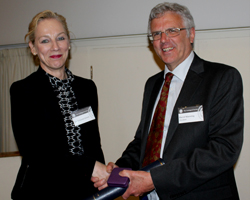
We come now to the Bigsby Medal, which this year is awarded to Professor Liane Benning from the German Research Centre for Geosciences in Potsdam, Germany and the University of Leeds, UK. Liane was unable to attend and the award was accepted on her behalf by Prof Eva Valsami-Jones.
Liane Benning is a pioneer of environmental geosciences. During her career, she has tackled a number of fundamental environmental problems - ranging from mineral nucleation and growth to bio-mineral interactions in extreme environments – with the aim of understanding the mechanisms that control these processes.
The core feature of her achievement is her ability to transgress scientific boundaries and find fruitful new avenues of research, often applying techniques that, while widely used in one area, are completely new elsewhere. This is evident from her impressively diverse publication record, which ranges from such core journals as Nature and other titles in the Nature stable, to core geology and geochemistry journals like Geochimica et Cosmochimica Acta and Science, or others - less mainstream perhaps to us – like Astrobiology or Frontiers in Microbiology.
Her most fundamental contribution has been her work using synchrotron-based techniques, elucidating molecular-level mechanisms for mineral reactions in situ and in real-time. However, in her research Liane has employed a wide range of different methodologies - from high-resolution micro-spectroscopy to genomic techniques because these helped her and her team to elucidate mineral formation mechanisms or determine the diversity and function of microbial communities in extreme environments.
She is unique as a scientist who finds herself equally home in the field and the laboratory, and it is this powerful combination that has enabled her to create some of her most impactful science, conveyed in highly cited papers published in such a wide variety of influential journals.
Liane Benning replied:
President, although trained in Geology and Mineralogy, I am seemingly a jack of all trades and a master of none because of multiple stages of discipline hopping. This allowed me draw my questions from Earth Observations, yet address processes at the interfaces between geology and other research fields. I consider it therefore a special honour to be awarded the Geological Society’s 2016 Bigsby Medal in recognition of my contributions to the wider Earth Sciences research.
Since an early age I was fascinated by why and how things change on Earth and thus geosciences was the natural home for my curiosity; my interest in caving also taught me that interface between water and minerals (and later biology) play crucial roles in shaping what we observed and describe as geological processes on Earth. Throughout my career I studied processes that questions related to metamorphic processes in ophiloites (MSc), I deciphered how and why gold dissolves in stinky hydrogen sulphide rich solutions (PhD) and today I am curious as to how and why nanomaterials form from solution or how I can use various ‘omics’ tools to elucidate microbial processes that affect the accelerated melting of Arctic glaciers and their link to climate change. These are all Earth Science questions but I address them at different scales.
Indeed discipline-hopping is a lot of hard work both in convincing someone that as a novice in a field you have a new idea worth pursuing and funding and – and even more importantly – to find curious and enthusiastic students, postdocs and collaborators who trust you and ultimately make research and the pain worth wile. It still is a never-ending pleasure.
I also want to point out that I am proud to be the third Woman receiving this award, following in the footsteps of real geologists like Janet Vida Watson in 1965 and Sarah Russell in 1995.
Thus, Mr President, again I thank you, and those who nominated me for this considerable honour.
We now come to the Society’s two Coke medals, awarded to geoscientists who have made a significant scientific contribution and been of significant service to geology through activities of benefit to the community.
Monica Grady (Coke Medal)
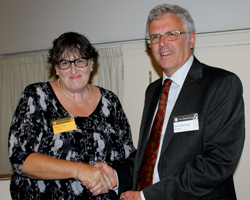 Monica Grady is renowned for her extensive work on meteorites, but her contribution to the public understanding of science is also outstanding, having made her one of this country’s best-known female scientists. She has been President of the Society for Popular Astronomy and has also delivered the Royal Institution Christmas Lectures to Young People.
Monica Grady is renowned for her extensive work on meteorites, but her contribution to the public understanding of science is also outstanding, having made her one of this country’s best-known female scientists. She has been President of the Society for Popular Astronomy and has also delivered the Royal Institution Christmas Lectures to Young People.
Within the scientific community she has also been phenomenally busy on national and international scientific committees, for example, chairing the STFC Solar System Advisory Panel, becoming Vice President of the Royal Astronomical Society, belonging to several committees of the European Space Agency and serving recently as President of the Meteoritical Society.
She has also been an associate editor of several major international journals, including Elements, the International Journal of Astrobiology, Geochimica et Cosmochimica Acta and the Meteoritical Bulletin. She is currently Professor of Planetary and Space Sciences at the Open University.
Monica began her career at Durham, obtaining her first degree in Chemistry and Geology; moving then to Cambridge to do a PhD in the application of stable isotopes to understanding the origin of meteorites. Her interest in meteorites is directed principally towards answering the question of how elements such as carbon and nitrogen were delivered to planets in the inner Solar System during and after accretion, thus paving the way to the origin of life on Earth.
She has also notably investigated the nature of carbonaceous material trapped in meteorites from Mars, as well as the carbon cycle on the Red Planet itself.
Monica Grady, these achievements underline the breadth of work now being conducted in planetary science by geologists and geochemists within the broader UK geological community, and render you a more than worthy recipient of the Coke Medal of The Geological Society of London.
Monica Grady replied extempore.
Patience Cowie (Coke Medal)
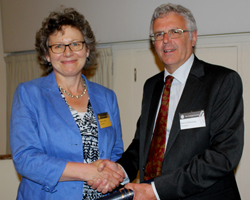
The second of the Society’s Coke medals is awarded to Patience Cowie, Professor in Earth Science at the University of Bergen.
Patience Cowie’s research career has been outstanding from its outset: her seminal PhD work, carried out with Chris Scholz at the Lamont-Doherty Earth Observatory, produced novel insights into the way faults grow and interact, and explained the physical mechanisms behind fault linkage and the reason why fault displacement-length scaling occurs in natural systems.
Subsequent work at Edinburgh University, as a NERC then Royal Society Postdoctoral Fellow, sought to explain the growth histories of normal faults, the development and significance of fault damage zones and the implications of this for fault spacing and slip-rate enhancements in interacting arrays.
During the next two decades, Patience broadened her research to address the role of active faults in landscape evolution and the way faults control the locus, routing and architectures of sedimentary deposits, and river long-profiles.
Patience’s research is characterized by deep clarity of thought, and represents a judicious combination of numerical modelling, seismic analysis and field observation. It has been so extensively cited – over 5000 times, including nearly20 papers with more than 100 citations each - because it exerts explanatory power across many fields, including geophysics, structural geology, rock mechanics and active tectonics.
Patience was promoted at Edinburgh to full Professor in 2008 before taking the Chair in Earth System Dynamics at the University of Bergen in 2011, and she is currently co-leading the Statoil-Norwegian Multi-Rift Project.
Patience Cowie, you are an inspirational and far-sighted geoscientist, who has revolutionized our understanding of the growth and interaction of faults. You have also made significant contributions to the geological community, not least as Editor of Geology. These many achievements make you a worthy recipient of the Coke Medal of The Geological Society of London.
Patience Cowie replied:
Mr President, thank you for your kind words. I am deeply honoured to receive a Coke medal and am delighted to be part of this Awards Ceremony.
First of all, my thanks go to my collaborators and colleagues both here in the UK and at the University of Bergen. I am particularly grateful to the many colleagues who have continued to involve me in exciting research projects in spite of my extended periods of sick leave over recent years.
The citation refers to my role as an editor for Geology, which, on a daily basis, produced feelings of both dread and excitement! Dread because it sometimes involved tough decisions, but excitement because of the wide variety of top quality papers that I had the opportunity to read.
My broad interests were first nurtured by my father who, while I was growing up, was excitedly developing revolutionary engineering projects. The opportunity to discover my passion for geology came while I was an undergraduate at Durham University. I remember the many field trips that we were lucky enough to experience, exploring the geology right outside ‘our back door’. It felt like wandering through the pages of a beautifully illustrated book - each new trip was a window into a different period of geological time. At Durham I also gained the confidence to apply for a PhD project at Columbia University, at a time when women in geology were a rare breed, and from that moment on I have, as they say, never looked back.
I would particularly like to thank Chris Scholz who, as my PhD supervisor, gave me the opportunity and the motivation to pursue a career in academia. And last but certainly not least my daughters, Esther and Saskia, and my totally amazing husband (and now co-author!) Leo Zijerveld.
Michael de Freitas (William Smith Medal)
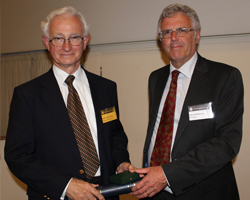
The medal named for William Smith celebrates outstanding achievement in the field of applied geology, and this year we are delighted to present it to Dr Michael de Freitas, of Imperial College London.
During his long and distinguished career, Mike de Freitas’s contribution to applied geology has been outstanding in breadth and depth, centring on the application of geology at far-field and near-field scales to engineering design and construction in soil and rock – including the prediction and control of groundwater.
Mike has over 40 years’ research experience with rock and soil slopes, the shear-strength of clean and infilled rock surfaces, comminution within shear-zones, rock and mineral reaction to water, weak rocks and the nature of boundary layers – all of which topics are reflected in his key publications.
In addition to his ‘day job’ running the renowned MSc Engineering Geology course and research department at Imperial College with distinction until 2007, Mike has made significant contributions as a consultant, author and as Chairman of this Society’s Promotions Committee, commissioning and publishing the highly successful Handbook Series of practical fieldwork guides. These remain in print today and are among our most successful titles.
Mike’s tireless committee work for the Society, which has also included Editorship of the Quarterly Journal of Engineering Geology, Chairmanship of its Engineering Group, and of the Fellowship and Validation Committee at a time of drastic change for Chartership, and his service to its Special Publications, including its most recent on ‘The engineering geology and geomorphology of glaciated and periglacial terrains’, has been outstanding.
Mike reawakened an interest in the geology under London and opened the way for many problems encountered by ground engineering in London to be seen within a geological framework that permits explanations and predictions to be made of what were formally viewed as a disparate collection of “anomalies”.
Mike de Freitas replied:
Mr President and Fellows; William Smith entered my life in the 1950s when, by virtue of his astonishing map, I heard of him being the “Father of English geology”. For me he was a schoolboy hero who ranked with Capt. Robert Scott, Ernest Shackleton, and Edmund Hillary. It was then that I was brought to these apartments and came face to face with William’s portrait, and his lock of hair. It is a moment I have never forgotten and one I have often remembered whilst attempting to produce a commercial atlas for the geology of London. In this endeavour Smith has been my exemplar as we have travelled on similar paths, and so to be standing here now, holding the Society’s medal in his memory, is for me an honour beyond compare.
Of course I would not be here were it not for the countless many who have helped me, by opening doors, straightening paths and providing shoulders on which I could stand. It is a shame their contribution cannot be recorded, but to them I offer the same sentiments that Adam Sedgwick offered to William Smith when presenting him with the first and highest award of the Society; he said “.it was he that gave the plan, and laid the foundations and erected a portion of the solid walls..” and that is what I would like to say in thanks and recognition to those who are not mentioned on this medal and from whose generosity, in spirit and in substance, I have benefited.
Mr President, by happy good fortune the Society’s William Smith medal means more to me than any other. I am humbled that others should consider me worthy of it and accept it knowing I share it with my many colleagues past and present. Thank you.
Jon Blundy (Murchison Medal)
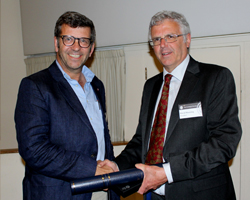
Sir Roderick Impey Murchison was one of the 19th Century’s most widely travelled Earth scientists, and we bestow the medal named for him today on Professor Jon Blundy FRS, of the University of Bristol.
Jon is currently Professor of Petrology in the Department of Earth Sciences, his academic home since 1991 when he joined as a NERC postdoctoral research Fellow. As his record for winning awards attests – including this Society’s Murchison Fund and Bigsby Medal – Jon is a phenomenally successful scientist who combines great insight with a knack for spotting potentially fruitful research directions.
Success came early – his most-cited study being his development of a geothermometer, using thermodynamic equilibrium between co-existing hornblende and plagioclase to determine crystallization temperatures. The basis for this work was laid while at MIT as a Kennedy Memorial Scholar.
At Bristol, Jon began a fruitful collaboration with Bernie Wood and others, studying trace element partitioning in a range of minerals and melts. They went on later to develop an understanding of how elastic strain theory can explain the controls on trace-element partitioning in minerals – which opened up the possibility of fully predictive models of trace element distributions during mantle melting.
A subsequent research partnership, with Professor Kathy Cashman, then at the University of Oregon (where he spent a sabbatical as a Fulbright Scholar) has shown that the composition of melt inclusions change systematically in relation to changes in entrapment pressure, possibly resulting from undercooling experienced as a result of volatile degassing. This opened further avenues of research, including decompression crystallization, the nature of subduction zone magmatism, and the importance of volatiles in arc magmas.
Jon Blundy, world-leading petrologist with an unusually broad range of interests, outstanding reputation and exceptional publication record, you are a worthy recipient of the Murchison Medal of The Geological Society.
Jon Blundy replied:
Thank you, Mr President, for those kind words. It is a great honour to receive the Murchison Medal. The list of previous medallists not only contains the names of many geological luminaries from the past 143 years, but also includes three geologists who played a considerable part in getting me enthused about igneous rocks and what one can learn from them.
The late Keith Cox at Oxford taught me all I know about igneous phase diagrams, delivered at the time through a dense fog of pipe smoke in his Parks Road office. Steve Sparks supervised my PhD at Cambridge, where he instilled in me the importance of field observation and taught me never to be afraid to challenge the orthodoxy. I moved to Bristol with Steve as a post-doc in 1989 and have been there ever since. Also coming to Bristol at that time was Bernie Wood, now at Oxford. From Bernie I learned a huge amount about thermodynamics and together we worked for over 15 years on the problem of trace element partitioning between crystal and melts. That was a whole lot of fun.
As we all know, it is great teachers that make the difference, whatever the subject. Meeting such teachers is more a matter of luck than planning. In addition to Keith, Steve and Bernie, I reserve a special mention for David Bell, my undergraduate tutor at Oxford. As well as being an igneous petrologist and inspirational tutor, David was also the Dean of University College, the Fellow charged with maintaining discipline.
This came in very handy on those few occasions when my behaviour fell below the high standards expected of Oxford undergraduates in the 1980s. Without his benign intervention, I rather doubt I would have been standing here today. I feel supremely lucky to have had such wonderful mentors and thank them all very much.
John Underhill (Lyell Medal)
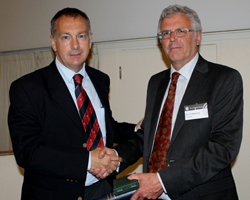
The medal named for one of the 19th Century’s most influential geologists, Sir Charles Lyell, goes this year to Professor John Underhill of Heriot-Watt University.
Few academics have made a more significant contribution to our understanding of UK Continental Shelf geology than John Underhill. Founded on over 170 publications, receiving over 3500 citations, John’s research has occupied the forefront of North Sea geology and petroleum geology for the last 30 years.
John is the driving force behind the NERC Centre for Doctoral Training (CDT) in Oil and Gas Centre led by and based at Heriot-Watt University. His vision, collegiate drive and inspired leadership has led to a unique collaboration between 17 universities, 2 NERC Research Centres and 11 industry sponsors, who sponsor its Training Academy.
The CDT, funded to a total of >£11 million from combined government and industry sources, is a game-changing initiative, and embodies John’s commitment to inspiring the next generation of geoscientists. Without him, the CDT could not have garnered so much industrial support, and would never have become one of the most successful doctoral training initiatives anywhere. The Prime Minister recently announced an extension and £1Million cash injection to support the CDT, something that underlines its success.
John has also been at the forefront of establishing the Sir Charles Lyell Centre for Earth and Marine Science & Technology, a £20m initiative that has seen the British Geological Survey (BGS) move from Murchison House to Heriot-Watt’s Riccarton Campus on the outskirts of Edinburgh. Formally opening later this year, the Lyell Centre is destined to become an international hub of a world leading geoscientific research - bringing science and technology bear on critical issues of natural resource and energy supply in a responsible and sustainable way.
John Underhill is an inspiring mentor, and universally respected for professional integrity – a fact borne out by his being the only academic representative on the UK Government’s Oil and Gas Technology Leadership Board (TLB). Here perhaps, his many years’ experience as a Football Association (FIFA) referee will stand him in good stead.
John Underhill replied:
Thank you Mr President; it is a great honour to receive this medal, named for Charles Lyell who has a particular association with Heriot-Watt University having married Mary Horner, the daughter of its founding father and who was instrumental in the early development of Natural History teaching on the College’s Edinburgh campus in the early 19th Century.
Lyell also inspired Charles Darwin, who took Principles of Geology on his voyages and used it much as a guide to geoscientific method throughout his life.
Receipt of such a prestigious award causes one to reflect upon the people and places that have influenced the career path that has led here today,
I wish to acknowledge three school teachers, “Duffy” Clayton, John Hopkinson and Christine Dixon, who went the extra mile to put on Geology O and A levels at Portsmouth Grammar School when none existed previously to selflessly serve the appetite of a small band of pupils who wished to follow the subject.
My passion for the subject was subsequently nurtured at Bristol by staff such as Re Bradshaw, Doug Robinson, Paul Hancock, David Dineley, Brian Williams and Phil Kearey, all of whom were dedicated to educating the next generation in good geological and geophysical practice. A PhD followed at University College, Cardiff where I worked on the Late Neogene and Quaternary Tectonics and Sedimentation of Western Greece. I greatly benefited from the tutelage of Philip Allen as his first PhD student
Having completed my PhD, I joined Shell International and spent 5 enjoyable years learning and practicing subsurface exploration from the likes of Ken Glenniw, Peter Ziegler and Berend Van Hoorn before returning to academia to take up a lectureship at Edinburgh University in 1989 and then taking the Chair of Stratigraphy there in 1998. Throughout my time at Edinburgh, John Dixon proved to be a fantastic mentor and sounding-board. He died in 2013 and I miss him greatly.
I moved to Heriot-Watt 3 years ago and have enjoyed the support of the University Executive in building our Applied Geoscience capability, which now includes a new Centre for Exploration Geoscience housing the Shell-sponsored Wouter Hoogeveen seismic interpretation laboratory. I acknowledge and thank Drs Ceri Powell, Jeroen Peters, Jack Russell & Keith Gerdes for their support for the build of Heriot-Watt’s geoscience base since my move there.
The University have also supported the construction of the Lyell Centre for Earth and Marine Science & Technology in which the British Geological Survey (BGS Scotland) are now co-located. The formal opening of the Centre will occur in the Autumn.
In addition, I have been afforded the opportunity and privilege to lead the NERC Centre for Doctoral Training (CDT) in Oil and Gas, a pan-UK partnership involving 17 Universities, 2 NERC Research centres and 11 industry partners who sponsor the CDT’s Training Academy.
My research has benefited enormously from the inspiration and constructive challenge of numerous colleagues around the world; from the energy and commitment of a stream of talented postgraduate (MRes, PhD and Postdoctoral) students from whom I have learnt and gained so much; and from the tremendous support and patience of all my friends and my family.
It is not only an honour to be Heriot-Watt’s first member of academic staff to be the recipient of the Lyell Award, but also for my name to appear alongside a former illustrious Heriot-Watt alumni, Dame May Ogilvie-Gordon, who was the first female recipient of the award. At a time when it was difficult for women to study geology, I am proud to be based at Heriot-Watt a far-sighted institution that enabled Dame Ogilvie-Gordon to fulfil that ambition and go on to get a PhD in the subject when other institutions did not permit women to study. As well as winning the Lyell medal, it is worth stating that she was also the first female Fellow of the Geological Society, and was on the board that founded the League of Nations (the United Nations as we know it today).
I gratefully accept this Lyell Medal on behalf of all who have helped me during my career to date and acknowledge everyone who has played a part along the way.
Finally, we come to the Wollaston Medal – the Society’s senior medal and highest accolade, first awarded to William Smith in 1831.
Susan Brantley (Wollaston Medal)
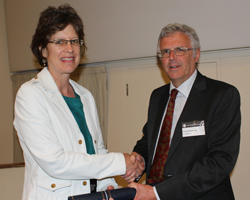
Today this most prestigious accolade goes to Professor Susan Brantley of Pennsylvania State University.
Susan Brantley, author of over 200 scientific papers, has published extensively across the whole range of disciplines relating to fluid-mineral reactions in low-temperature environments; the tectonic, climatic and environmental implications of these processes and the importance of biology in these reactions; and CO2 emissions from volcanoes and faults. The breadth and influence of her work is unparalleled.
Very few scientists carry out such a wide range of studies in both laboratory and the field. In mineral-fluid reactions, her important papers range from observations and modelling at the atomic scale, to laboratory studies of mineral dissolution rates (many of which are now classics), to field studies of detailed processes, integrated field studies of whole catchments and a highly cited paper on pyrite size-distributions as redox indicators.
These studies have involved the application – often, the development - of many different techniques, including analysis of novel stable-isotope systems, Uranium-Thorium chronometers, and detailed reactive transport modelling (especially of weathering rinds and regolith). Over 40 papers concern the ways in which biology and biological products contribute to weathering processes - a very difficult subject area at the cutting edge of geoscience research.
Susan Brantley has played a critical role in managing and organising science - notably, establishing the Critical Zone Observatory Network, which now has nine major field observatories up and running in the USA. These stations possess the complex infrastructure and resources needed for time-series observations, as well as – behind them - the collaborative network of scientists capable of making the multi-disciplinary observations required to understand some of the most complex and important geological environments on Earth.
A recent example of her research acumen is exemplified by her attention to environmental questions raised by shale gas exploitation, publishing a series of papers on implications for surface and groundwater pollution, as well as more fundamental papers on the properties of the host shales.
Susan Brantley has served on 13 NRC/NSF committees concerned with national facilities, the direction of science, and major environmental issues - including nuclear waste disposal and shale gas. These efforts include an appointment by President Barack Obama to the Nuclear Waste Technical Review Board. She is a past President of the Geochemical Society and has been involved with editing four journals.
She is currently Director of the Earth & Environmental Systems Institute, in the College of Earth and Mineral Sciences at Penn State. Her academic record and service have been recognised by numerous awards, culminating in membership of the US National Academy of Sciences.
Susan Brantley – you have dominated research in the area of fluid-mineral reactions in low temperature environments, and your work carries major economic implications and environmental importance. You are a profoundly important figure in geoscience today. It therefore gives me the greatest pleasure to acknowledge your outstanding achievements by conferring upon you now the Wollaston Medal of The Geological Society of London.
Susan Brantley replied:
Thank you for that wonderful attribution. I am overwhelmed. May I say, “wow”?! What a tribute. The medal itself is a bit like a baton that has been carried by a relay-race of scientists for almost 200 years. The runners with the baton are humbling: people like William Smith, Charles Darwin, Charles Lyell, James Dana. (Wow).
As scientists we are lucky to be handed a few batons – maybe a medal such as this one, or a scientific idea or a question – and allowed to carry them down the track with the privilege of passing them to others. Some of the scientific ideas and questions I now carry were carried by Wollaston medalists G K Gilbert and Victor Goldschmidt. But, stretching the analogy further, in life I also carry the baton passed by my mother - to stubbornly insist on combining fun and family (and some ferocity) while female. The analogy is not perfect because none of these batons is meant to be run down the track with speed alone. More importantly, they are meant to be run with quality of thought or time spent.
Scientific ideas are also not immutable metal rods. Rather, they are meant to be tested, changed, thrown away, forgotten, and then sometimes re-discovered, amplified and evolved. The most useful batons we carry as scientific runners change the track itself by amplifying our ability to understand pieces of the world. For me, this amplification is achieved through collaboration with others with differing viewpoints. Learning how the world works while working with other scientists is the pleasure I most enjoy in science.
So, let me acknowledge some co-authors, starting with my Princeton PhD advisor, David Crerar, and my long-time colleague and weathering expert, Art White. I thank my French geochemistry co-authors, Jacques Schott, Jerome Gaillardet, Francois Chabaux, and Yves Godderis. I acknowledge Penn State co-authors Jim Kubicki, Peter Heaney, and Lee Kump. I also call out structural geologist Don Fisher and mathematical chemist Marina Lebedeva. I call out rock mechanics colleagues Ray Fletcher and Brian Evans.
Finally, I thank my geophysicist husband co-author, Andy Nyblade, who enables my life as a scientist while female. He makes it possible to run on the track as a woman, a mother, and a wife.
I hope my run changed the track scientifically. I also hope my run changed the track to invite in more women. Such changes in the track and the batons that I pass to students are my most rewarding contributions. I cannot name my students but I am proud that one, Heather Buss, works in England.
Each student runs with me for a while and then carries the baton past where I can go. For the last 20 years I have also been privileged to be running with my two daughters, Maddy and Lena Nyblade. They too are holding fast to batons and are running for themselves along the tracks they choose. I am grateful.
Thank you, all of you.